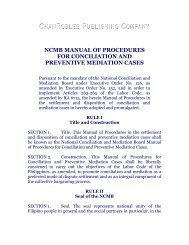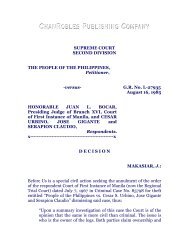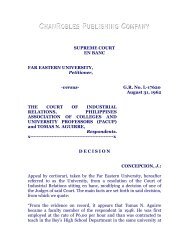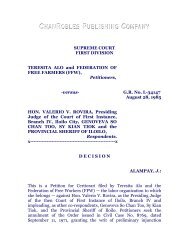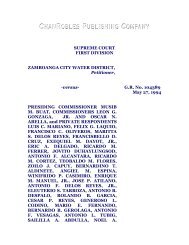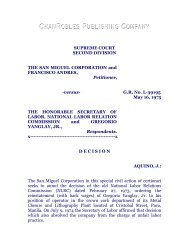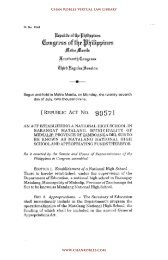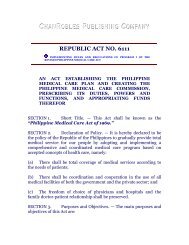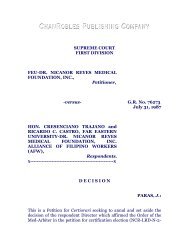Union of Filipro Employees vs. NLRC - Chan Robles and Associates ...
Union of Filipro Employees vs. NLRC - Chan Robles and Associates ...
Union of Filipro Employees vs. NLRC - Chan Robles and Associates ...
- No tags were found...
You also want an ePaper? Increase the reach of your titles
YUMPU automatically turns print PDFs into web optimized ePapers that Google loves.
SUPREME COURTFIRST DIVISIONUNION OF FILIPRO EMPLOYEES,Petitioner,-versus- G.R. No. 91025December 19, 1990THE HONORABLE NATIONAL LABORRELATIONS COMMISSION <strong>and</strong>NESTLE PHILIPPINES, INC.,Respondents.x---------------------------------------------------xR E S O L U T I O NMEDIALDEA, J.:This Special Civil Action <strong>of</strong> Certiorari assails the resolution (datedJune 5, 1989) <strong>of</strong> the National Labor Relations Commission (<strong>NLRC</strong>)relative to Certified Case No. 0522, <strong>and</strong> the resolution denying themotion for reconsideration (dated August 8, 1989). chanroblespublishingcompanyThe antecedents are:On June 22, 1988, the petitioner <strong>Union</strong> <strong>of</strong> the <strong>Filipro</strong> <strong>Employees</strong>, thesole <strong>and</strong> exclusive bargaining agent <strong>of</strong> all rank-<strong>and</strong>-file employees <strong>of</strong>Nestle Philippines, (private respondent) filed a Notice <strong>of</strong> Strike at the
Department <strong>of</strong> Labor raising the issues <strong>of</strong> CBA deadlock <strong>and</strong> unfairlabor practice. chanroblespublishingcompanyThe National Conciliation <strong>and</strong> Mediation Board (NCMB) invited theparties for a conference on February 4, 1988 for the purpose <strong>of</strong>settling the dispute. The private respondent however, assailed thelegal personality <strong>of</strong> the proponents <strong>of</strong> the said notice <strong>of</strong> strike torepresent the Nestle employees. This notwithst<strong>and</strong>ing, the NCMBproceeded to invite the parties to attend the conciliation meetings <strong>and</strong>to which private respondent failed to attend contending that it willdeal only with a negotiating panel duly constituted <strong>and</strong> m<strong>and</strong>ated inaccordance with the UFE Constitution <strong>and</strong> By-laws.The records show that before the filing <strong>of</strong> said notice <strong>of</strong> strike, or onJune 30, 1987, the respective CBAs in the four (4) units <strong>of</strong> Nestle, inAlabang-Cabuyao, Makati, Cagayan de Oro <strong>and</strong> Cebu/Davao worklocations had all expired. Under the said CBAs, Alabang/Cabuyao <strong>and</strong>Makati units were represented by the UFE; the Cagayan de Oro unitwas represented by WATU; while the Cebu-Davao was represented byTUPAS. Prior to the expiration <strong>of</strong> the CBAs for Makati <strong>and</strong>Alabang/Cabuyao, UFE submitted to the company a list <strong>of</strong> CBAproposals. The company, on the other h<strong>and</strong>, expressed its readinessto negotiate a new CBA for Makati <strong>and</strong> Alabang/Cabuyao units butreserved the negotiation for Cagayan de Oro <strong>and</strong> Cebu-Davaoconsidering that the issue <strong>of</strong> representation for the latter units wasnot yet settled. On June 10, 1987 <strong>and</strong> July 28, 1987, UFE was certifiedas the sole <strong>and</strong> exclusive bargaining representative <strong>of</strong> Cagayan de Oro<strong>and</strong> Cebu/Davao units, respectively.On September 14, 1987, the Company terminated from employmentall UFE <strong>Union</strong> <strong>of</strong>ficers, headed by its president, Mr. ManuelSarmiento, <strong>and</strong> all the members <strong>of</strong> the negotiating panel forinstigating <strong>and</strong> knowingly participating in a strike staged at theMakati, Alabang, Cabuyao <strong>and</strong> Cagayan de Oro on September 11, 1987without any notice <strong>of</strong> strike filed <strong>and</strong> a strike vote obtained for thepurpose. chanroblespublishingcompanyOn September 21, 1987, the union filed a complaint for illegaldismissal. The Labor Arbiter, in a decision dated January 12, 1988,upheld the validity <strong>of</strong> the dismissal <strong>of</strong> said union <strong>of</strong>ficers. The
decision was later on affirmed by the respondent <strong>NLRC</strong> en banc, onNovember 2, 1988.Respondent company contends that, “with the dismissal <strong>of</strong> UFE<strong>of</strong>ficers including all the members <strong>of</strong> the union negotiating panel aslater on confirmed by the <strong>NLRC</strong> en banc, said union negotiating panelthus ceased to exist <strong>and</strong> its former members divested <strong>of</strong> any legalpersonality, st<strong>and</strong>ing <strong>and</strong> capacity to act as such or represent theunion in any manner whatsoever.”The union <strong>of</strong>ficers, on the other h<strong>and</strong>, asserted their authority torepresent the regular rank-<strong>and</strong>-file employees <strong>of</strong> Nestle, Philippines,being the duly elected <strong>of</strong>ficers <strong>of</strong> the union. chanroblespublishingcompanyIn the meantime, private respondent sought guidelines from theDepartment <strong>of</strong> Labor on how it should treat letters from severalsplinter groups claiming to have possessed authority to negotiate inbehalf <strong>of</strong> the UFE. It is noteworthy that aside from the names <strong>of</strong> thenegotiating panel submitted by one UFE <strong>of</strong>ficials, three (3) othergroups in the Nestle plant in Cabuyao <strong>and</strong> two groups in the Makati<strong>of</strong>fice have expressed a desire to bargain with management pr<strong>of</strong>essingalleged authorization from <strong>and</strong> by the general membership. Thesegroups however, it must be noted, belong to just one (1) union, theUFE.In a letter dated August 20, 1988, BLR Director Pura Ferrer-Callejaadvised:“Any attempt on the part <strong>of</strong> management to directly deal withany <strong>of</strong> the factions claiming to have the imprimatur <strong>of</strong> themajority <strong>of</strong> the employees, or to recognize any act by aparticular group to adopt the deadlock counter proposal <strong>of</strong> themanagement, at this stage, would be most unwise. It may onlyfan the fire.” (Rollo, pp. 61-62) chanroblespublishingcompanyOn March 20, 1988 <strong>and</strong> August 5, 1988, the company concludedseparate CBAs with the general membership <strong>of</strong> the union atCebu/Davao <strong>and</strong> Cagayan de Oro units, respectively. The workersthereat likewise conducted separate elections <strong>of</strong> their <strong>of</strong>ficers.
Assailing the validity <strong>of</strong> these agreements, the union filed a case <strong>of</strong>ULP against the company with the <strong>NLRC</strong>-NCR Arbitration Branch onNovember 16, 1988.Efforts to resolve the dispute amicably were taken by the NCMB butyielded negative result because <strong>of</strong> the irreconcilable conflicts <strong>of</strong> theparties on the matter <strong>of</strong> who should represent <strong>and</strong> negotiate for theworkers.On October 18, 1988, petitioner filed a motion asking the Secretary <strong>of</strong>Labor to assume jurisdiction over the dispute <strong>of</strong> deadlock in collectivebargaining between the parties. On October 28, 1988, Labor SecretaryFranklin Drilon certified to the <strong>NLRC</strong> the said dispute between theUFE <strong>and</strong> Nestle, Philippines, the relevant portion <strong>of</strong> which reads asfollows:“WHEREFORE, above premises considered, this <strong>of</strong>fice herebycertifies the sole issue <strong>of</strong> deadlock in CBA negotiations affectingthe Makati, Alabang <strong>and</strong> Cabuyao units to the National LaborRelations Commission for compulsory arbitration. chanroblespublishingcompany“The <strong>NLRC</strong> is further directed to call all the parties immediately<strong>and</strong> resolve the CBA deadlock within twenty (20) days fromsubmission <strong>of</strong> the case for resolution.” (Rollo, p. 225)On June 5, 1989, the Second Division <strong>of</strong> the <strong>NLRC</strong> promulgated aresolution granting wage increase <strong>and</strong> other benefits to Nestle’semployees, ruling on non-economic issues, as well as absolving theprivate respondent <strong>of</strong> the Unfair Labor Practice charge. Thedispositive portion states as follows:“WHEREFORE, as aforestated, the parties are hereby orderedto execute <strong>and</strong> implement through their duly authorizedrepresentatives a collective bargaining agreement for a duration<strong>of</strong> five (5) years from promulgation <strong>of</strong> this Resolution. chanroblespublishingcompany“SO ORDERED.” (Rollo, p. 180)
Petitioner finds said resolution to be inadequate <strong>and</strong> accordingly,does not agree therewith. It filed a motion for reconsideration, whichwas, however, denied on August 8, 1989.Hence, this petition for certiorari.Petitioner originally raised 13 errors committed by the publicrespondent. However, in its Urgent Manifestation <strong>and</strong> Motion datedSeptember 24, 1990, petitioner limited the issues to be resolved intosix (6). Thus, only the following shall be dealt with in this resolution:1. WHETHER OR NOT THE SECOND DIVISION OF THE<strong>NLRC</strong> ACTED WITHOUT JURISDICTION INRENDERING THE ASSAILED RESOLUTION, THE SAMEBEING RENDERED ONLY BY A DIVISION OF THEPUBLIC RESPONDENT AND NOT BY EN BANC;2. WHETHER OR NOT THE RESPONDENT <strong>NLRC</strong>SERIOUSLY ERRED IN HOLDING THAT THE CBA TOBE SIGNED BY THE PARTIES SHALL COVER SOLELYTHE BARGAINING UNIT CONSISTING OF ALLREGULAR RANK-AND-FILE EMPLOYEES OF THERESPONDENT COMPANY AT MAKATI, ALABANG ANDCABUYAO;3. WHETHER OR NOT THE RESPONDENT <strong>NLRC</strong> HADACTED WITH GRAVE ABUSE OF DISCRETION ANDCOMMITTED SERIOUS ERRORS IN FACT AND IN LAWWHEN IT RULED THAT THE CBA IS EFFECTIVE ONLYUPON THE PROMULGATION OF THE ASSAILEDRESOLUTION; chanroblespublishingcompany4. WHETHER OR NOT PUBLIC RESPONDENT HADSERIOUSLY ERRED IN DENYING PETITIONER’SDEMAND FOR A CONTRACT SIGNING BONUS AND INTOTALLY DISREGARDING THE LONG PRACTICE ANDTRADITION IN THE COMPANY WHICH AMOUNT TODIMINUTION OF EMPLOYEES BENEFITS; chanroblespublishingcompany
5. WHETHER OR NOT PUBLIC RESPONDENT SERIOUSLYERRED IN NOT GRANTING THE UNION’S DEMANDFOR A “MODIFIED UNION SHOP” SECURITY CLAUSEIN THE CBA AS ITS RULING CLEARLY COLLIDES WITHSETTLED JURISPRUDENCE ON THE MATTER;6. WHETHER OR NOT PUBLIC RESPONDENT ERRED INENTIRELY ABSOLVING THE COMPANY FROM THEUNFAIR LABOR PRACTICE CHARGE AND INDISREGARDING THE SUBSTANTIAL INCRIMINATORYEVIDENCE RELATIVE THERETO; (p. 9, Petitioner’sUrgent Manifestation <strong>and</strong> Motion dated September 24,1990). chanroblespublishingcompanyCounsel for the private respondent company filed a motion for leave<strong>of</strong> court to oppose the aforesaid urgent manifestation <strong>and</strong> motion. Itappearing that the allowance <strong>of</strong> said opposition would necessarilydelay the early disposition <strong>of</strong> this case, the Court Resolved toDISPENSE with the filing <strong>of</strong> the same.We affirm the public respondent’s findings <strong>and</strong> rule as regards theissue <strong>of</strong> jurisdiction. chanroblespublishingcompanyThis case was certified on October 28, 1988 when existing rulesprescribed that, it is incumbent upon the Commission en banc todecide or resolve a certified dispute. However, R.A. 6715 took effectduring the pendency <strong>of</strong> this case. Aside from vesting upon eachdivision the power to adjudicate cases filed before the Commission,said Act further provides that the divisions <strong>of</strong> the Commission shallhave exclusive appellate jurisdiction over cases within their respectiveterritorial jurisdiction. chanroblespublishingcompanySection 5 <strong>of</strong> RA 6715 provides as follows:“Section 5. Article 213 <strong>of</strong> the Labor Code <strong>of</strong> the Philippines, asamended, is further amended to read as follows:Art. 213. National Labor Relations Commission. —There shall be a National Labor Relations Commissionwhich shall be attached to the Department <strong>of</strong> Labor <strong>and</strong>
Employment for program <strong>and</strong> policy coordination only,composed <strong>of</strong> (a) Chairman <strong>and</strong> fourteen (14) Members.Five (5) members each shall be chosen from among the nominees <strong>of</strong>the workers <strong>and</strong> employers organization, respectively. The Chairman<strong>and</strong> the four (4) remaining members shall come from the publicsector, with the latter to be chosen from among the recommendees <strong>of</strong>the Secretary <strong>of</strong> Labor <strong>and</strong> Employment. chanroblespublishingcompanyUpon assumption into <strong>of</strong>fice, the members nominated by the workers<strong>and</strong> employers organizations shall divest themselves <strong>of</strong> any affiliationwith or interest in the federation or association to which they belong.The Commission may sit en banc or in five (5) divisions, eachcomposed <strong>of</strong> three (3) members. The Commission shall sit en banconly for purposes <strong>of</strong> promulgating rules <strong>and</strong> regulations governingthe hearing <strong>and</strong> disposition <strong>of</strong> cases before any <strong>of</strong> its divisions <strong>and</strong>regional branches <strong>and</strong> formulating policies affecting itsadministration <strong>and</strong> operations. The Commission shall exercise itsadjudicatory <strong>and</strong> all other powers, functions <strong>and</strong> duties through itsdivisions. Of the five (5) divisions, the first <strong>and</strong> second divisions shallh<strong>and</strong>le cases coming from the National Capital Region <strong>and</strong> the third,fourth <strong>and</strong> fifth divisions, cases from other parts <strong>of</strong> Luzon, from theVisayas <strong>and</strong> Mindanao, respectively. The divisions <strong>of</strong> the Commissionshall have exclusive appellate jurisdiction over cases within theirrespective territorial jurisdiction. chanroblespublishingcompanyThe concurrence <strong>of</strong> two (2) Commissioners <strong>of</strong> a division shall benecessary for the pronouncement <strong>of</strong> a judgment or resolution.Whenever the required membership in a division is not complete <strong>and</strong>the concurrence <strong>of</strong> two (2) commissioners to arrive at a judgment orresolution cannot be obtained, the Chairman shall designate suchnumber <strong>of</strong> additional Commissioners from the other divisions as maybe necessary.The conclusions <strong>of</strong> a division on any case submitted to it for decisionshall be reached in consultation before the case is assigned to amember for the writing <strong>of</strong> the opinion. It shall be m<strong>and</strong>atory for thedivision to meet for purposes <strong>of</strong> the consultation ordained therein. Acertification to this effect signed by the Presiding Commissioner <strong>of</strong>
Section 36 <strong>of</strong> R.A. 6715 provides:“Section 36. Rule-Making Authority. — The Secretary <strong>of</strong> Labor<strong>and</strong> Employment is hereby authorized to promulgate such rules<strong>and</strong> regulations as may be necessary to implement theprovisions <strong>of</strong> this Act.” chanroblespublishingcompanyMoreover, it is to be emphasized <strong>and</strong> it is a matter <strong>of</strong> judicial noticethat since the effectivity <strong>of</strong> R.A. 6715, many cases have already beendecided by the five (5) divisions <strong>of</strong> the <strong>NLRC</strong>. We find no legaljustification in entertaining petitioner’s claim considering that theclear intent <strong>of</strong> the amendatory provision is to expedite the disposition<strong>of</strong> labor cases filed before the Commission. To rule otherwise wouldnot be congruous to the proper administration <strong>of</strong> justice. chanroblespublishingcompanyAs to the second issue, the Court is convinced that the publicrespondent committed no grave abuse <strong>of</strong> discretion in resolving onlythe sole issue certified to by the Secretary <strong>and</strong> formulating a CBAwhich covers the bargaining units consisting <strong>of</strong> all regular rank-<strong>and</strong>fileemployees <strong>of</strong> the respondent company at Makati, Alabang <strong>and</strong>Cabuyao only.In its assailed resolution, public respondent stated:“A perusal <strong>of</strong> the records <strong>and</strong> proceedings <strong>of</strong> this case revealsthat after the issuance by the Secretary <strong>of</strong> Labor <strong>of</strong> his Orderdated 28 October 1988 certifying the dispute to Us, the <strong>Union</strong>filed an Urgent Manifestation seeking the modification <strong>of</strong> thecertification order to include the Cebu Davao <strong>and</strong> Cagayan deOro divisions, the employees/workers therein being all bonafidemembers <strong>of</strong> the <strong>Union</strong> which is the sole <strong>and</strong> exclusivebargaining representative <strong>of</strong> all the regular rank-<strong>and</strong>-fileworkers <strong>of</strong> the company nationwide. Their non-inclusion in thecertification order, the union argues, would give premium to thealleged unlawful act <strong>of</strong> the Company in entering into separate‘Collective Bargaining Agreements’ directly with the workersthereat.
“In the same vein, the union manifested its intention to file acomplaint for ULP against the company <strong>and</strong> its <strong>of</strong>ficersresponsible for such act, which it eventually did. chanroblespublishingcompany“Considering that the <strong>Union</strong> had reserved the right to prosecutethe Company <strong>and</strong> its <strong>of</strong>ficers responsible for the allegedunlawful execution <strong>of</strong> the CBA directly with the union membersin Cagayan de Oro <strong>and</strong> Cebu/Davao units, as it has in fact filed acase which is now pending with our Arbitration Branch, theissue as to whether such acts constitute ULP is best heard <strong>and</strong>decided separately from the certified case, not only because <strong>of</strong>the evidentiary need to resolve the issue, but also because <strong>of</strong> thedelay that may ensue in the resolution <strong>of</strong> the present conflict.“Furthermore, the consolidation <strong>of</strong> the issue with the instantcase poses complicated questions regarding venue <strong>and</strong> joinder<strong>of</strong> parties. We feel that each <strong>of</strong> the issues propounded by theparties shall be better dealt with separately according to its ownmerits. chanroblespublishingcompany“Thus, We rule to resolve the sole issue in dispute certified tothis Commission, i.e., the deadlock in the collective bargainingnegotiations in Cabuyao/Alabang <strong>and</strong> Makati units.” (Rollo, pp.174-176)We agree. Public respondent’s resolution is proper <strong>and</strong> in fullcompliance with the order <strong>of</strong> the Secretary <strong>of</strong> Labor. Theconcomittant delay that will result in resolving petitioner’s motion forthe modification <strong>of</strong> the certification order to determine whether toinclude Cebu/Davao <strong>and</strong> Cagayan de Oro Divisions or not will defeatthe very purpose <strong>of</strong> the Secretary <strong>of</strong> Labor’s assumption <strong>of</strong>jurisdiction <strong>and</strong> his subsequent certification order for compulsoryarbitration. chanroblespublishingcompanyThe assumption <strong>of</strong> jurisdiction by the Secretary <strong>of</strong> Labor over labordisputes causing or likely to cause a strike or lockout in an industryindispensable to the national interest is in the nature <strong>of</strong> a policepower measure. It cannot be denied that the private respondent isengaged in an undertaking affected with public interest being one <strong>of</strong>the largest manufacturers <strong>of</strong> food products. The compelling
consideration <strong>of</strong> the Secretary’s assumption <strong>of</strong> jurisdiction is the factthat a prolonged strike or lockout is inimical to the national economy<strong>and</strong> thus, the need to implement some measures to suppress any actwhich will hinder the company’s essential productions isindispensable for the promotion <strong>of</strong> the common good. Under thissituation, the Secretary’s certification order for compulsoryarbitration which was intended for the immediate formulation <strong>of</strong> analready delayed CBA was proper.Corollarily, the <strong>NLRC</strong> was thereby charged with the task <strong>of</strong>implementing the certification order for compulsory arbitration. Asthe implementing body, its authority did not include the power toamend the Secretary’s order (University <strong>of</strong> Santo Tomas <strong>vs</strong>. NationalLabor Relations Commission, UST Faculty <strong>Union</strong>, G.R. No. 89920,October 18, 1990). chanroblespublishingcompanyFor the same reason, We rule that the prayer to declare therespondent company guilty <strong>of</strong> acts <strong>of</strong> unfair labor practice when itallegedly resorted to practices designed to delay the collectivebargaining negotiations cannot be subsumed in this petition, it beingbeyond the scope <strong>of</strong> the certification order.Petitioner argues that because <strong>of</strong> the public respondent’s actuation inthis regard, it committed grave abuse <strong>of</strong> discretion as it allowedmultiplicity <strong>of</strong> suits <strong>and</strong> splitting causes <strong>of</strong> action which are barred byprocedural rule.We cannot subscribe to this argument. In the recent case <strong>of</strong> thePhilippine Airlines, Inc. <strong>vs</strong>. National Labor Relations Commission,this Court had occasion to define what a compulsory arbitration is. Insaid case, this Court stated:“When the consent <strong>of</strong> one <strong>of</strong> the parties is enforced by statutoryprovisions, the proceeding is referred to as compulsoryarbitration In labor cases, compulsory arbitration is the process<strong>of</strong> settlement <strong>of</strong> labor disputes by a government agency whichhas the authority to investigate <strong>and</strong> to make an award which isbinding on all the parties. (G.R. No. 55159, 22 Dec. 89).” chanroblespublishingcompany
When sitting in a compulsory arbitration certified to by the Secretary<strong>of</strong> Labor, the <strong>NLRC</strong> is not sitting as a judicial court but as anadministrative body charged with the duty to implement the order <strong>of</strong>the Secretary. Its function only is to formulate the terms <strong>and</strong>conditions <strong>of</strong> the CBA <strong>and</strong> cannot go beyond the scope <strong>of</strong> the order.Moreover, the Commission is further tasked to act within the earliesttime possible <strong>and</strong> with the end in view that its action would not onlyserve the interests <strong>of</strong> the parties alone, but would also have favorableimplications to the community <strong>and</strong> to the economy as a whole. This isthe clear intention <strong>of</strong> the legislative body in enacting Art. 263paragraph (g) <strong>of</strong> the Labor Code, as amended by Section 27 <strong>of</strong> R.A.6175, which provides: chanroblespublishingcompany(g) When in his opinion, there exists a labor dispute causingor likely to cause a strike or lockout in an industryindispensable to the national interest, the Secretary <strong>of</strong> Labor<strong>and</strong> Employment may assume jurisdiction over the dispute <strong>and</strong>decide it or certify the same to the Commission for compulsoryarbitration. Such assumption or certification shall have theeffect <strong>of</strong> automatically enjoining the intended or impendingstrike or lockout as specified in the assumption or certificationorder. If one has already taken place at the time <strong>of</strong> assumptionor certification, all striking or lockout employees shallimmediately return to work <strong>and</strong> the employer shall immediatelyresume operations <strong>and</strong> readmit all workers under the sameterms <strong>and</strong> conditions prevailing before the strike or lockout.The Secretary <strong>of</strong> Labor <strong>and</strong> Employment or the Commissionmay seek the assistance <strong>of</strong> law enforcement agencies to ensurecompliance with this provision as well as with such orders as hemay issue to enforce the same. (Emphasis supplied) chanroblespublishingcompanyIn view <strong>of</strong> the avowed but limited purpose <strong>of</strong> respondent’sassumption <strong>of</strong> jurisdiction over this compulsory arbitration case, itcannot be faulted in not taking cognizance <strong>of</strong> other matters thatwould defeat this purpose. chanroblespublishingcompanyAs regards the third issue raised by petitioner, this Court finds theprovisions <strong>of</strong> Article 253 <strong>and</strong> Article 253-A <strong>of</strong> the Labor Code asamended by R.A. 6715 as the applicable laws, thus:
“Art. 253. Duty to bargain collectively when there exists acollective bargaining agreement. — When there is a collectivebargaining agreement, the duty to bargain collectively shall alsomean that neither party shall terminate nor modify suchagreement during its lifetime. However, either party can serve awritten notice to terminate or modify the agreement at leastsixty (60) days prior to its expiration date. It shall be the duty <strong>of</strong>both parties to keep the status quo <strong>and</strong> to continue in full force<strong>and</strong> effect the terms <strong>and</strong> conditions <strong>of</strong> the existing agreementduring the 60-day period <strong>and</strong>/or until a new agreement isreached by the parties. chanroblespublishingcompany“Art. 253-A. Terms <strong>of</strong> a collective bargaining agreement. — AnyCollective Bargaining Agreement that the parties may enter intoshall, ins<strong>of</strong>ar as the representation aspect is concerned, be for aterm <strong>of</strong> five (5) years. No petition questioning the majoritystatus <strong>of</strong> the incumbent bargaining agent shall be entertained<strong>and</strong> no certification election shall be conducted by theDepartment <strong>of</strong> Labor <strong>and</strong> Employment outside <strong>of</strong> the sixty-dayperiod immediately before the date <strong>of</strong> expiry <strong>of</strong> such five yearterm <strong>of</strong> the Collective Bargaining Agreement. All otherprovisions <strong>of</strong> the Collective Bargaining Agreement shall berenegotiated not later than three (3) years after its execution.Any agreement on such other provisions <strong>of</strong> the CollectiveBargaining Agreement entered into within six (6) months fromthe date <strong>of</strong> expiry <strong>of</strong> the term <strong>of</strong> such other provisions as fixedin the Collective Bargaining Agreement, shall retroact to the dayimmediately following such date. If any such agreement isentered into beyond six months, the parties shall agree on theduration <strong>of</strong> retroactivity there<strong>of</strong> . In case <strong>of</strong> a deadlock in therenegotiation <strong>of</strong> the collective bargaining agreement, the partiesmay exercise their rights under this Code.” (Emphasis supplied)In the light <strong>of</strong> the foregoing, this Court upholds the pronouncement <strong>of</strong>the <strong>NLRC</strong> holding the CBA to be signed by the parties effective uponthe promulgation <strong>of</strong> the assailed resolution. It is clear <strong>and</strong> explicitfrom Article 253-A that any agreement on such other provisions <strong>of</strong>the CBA shall be given retroactive effect only when it is entered intowithin six (6) months from its expiry date. If the agreement was
entered into outside the six (6) month period, then the parties shallagree on the duration <strong>of</strong> the retroactivity there<strong>of</strong>.The assailed resolution which incorporated the CBA to be signed bythe parties was promulgated June 5, 1989, <strong>and</strong> hence, outside the 6month period from June 30, 1987, the expiry date <strong>of</strong> the past CBA.Based on the provision <strong>of</strong> Section 253-A, its retroactivity should beagreed upon by the parties. But since no agreement to that effect wasmade, public respondent did not abuse its discretion in giving thesaid CBA a prospective effect. The action <strong>of</strong> the public respondent iswithin the ambit <strong>of</strong> its authority vested by existing laws. chanroblespublishingcompanyIn assailing the public respondent’s actuation, the <strong>Union</strong> cited thecase <strong>of</strong> Villar <strong>vs</strong>. Inciong (121 SCRA 444) where this Court ruled:“While petitioners were charged for alleged commission <strong>of</strong> acts<strong>of</strong> disloyalty inimical to the interests <strong>of</strong> the Amigo <strong>Employees</strong><strong>Union</strong>-PAFLU in the Resolution <strong>of</strong> February 14, 1977 <strong>of</strong> theAmigo-<strong>Employees</strong> <strong>Union</strong>-PAFLU <strong>and</strong> on February 15, 1977,PAFLU <strong>and</strong> the company entered into <strong>and</strong> concluded a newcollective bargaining agreement, petitioners may not escape theeffects <strong>of</strong> the security clause under either the old CBA or thenew CBA by claiming that the old CBA had expired <strong>and</strong> that thenew CBA cannot be given retroactive enforcement. To do sowould be to create a gap during which no agreement wouldgovern, from the time the old contract expired to the time a newagreement shall have been entered into with the union.” chanroblespublishingcompanyIn the aforecited case, the Court only pointed out that, it is not rightfor union members to argue that they cannot be covered by the past<strong>and</strong> the new CBAs both containing the same closed-shop agreementfor acts committed during the interregnum. What was emphasized bythis Court is that in no case should there be a period in which noagreement would govern at all. But nowhere in the saidpronouncement did We rule that every CBA contracted after theexpiry date <strong>of</strong> the previous CBA must retroact to the day followingsuch date. Hence, it is proper to rule that in the case at bar, the clear<strong>and</strong> unmistakable terms <strong>of</strong> Articles 253 <strong>and</strong> 253-A must be deemedcontrolling.
Articles 253 <strong>and</strong> 253-A m<strong>and</strong>ate the parties to keep the status quo<strong>and</strong> to continue in full force <strong>and</strong> effect the terms <strong>and</strong> conditions <strong>of</strong> theexisting agreement during the 60-day period prior to the expiration <strong>of</strong>the old CBA <strong>and</strong>/or until a new agreement is reached by the parties.Consequently, there being no new agreement reached, the automaticrenewal clause provided for by the law which is deemed incorporatedin all CBAs, provides the reason why the new CBA can only be given aprospective effect.Petitioner claims that because <strong>of</strong> the prospective effect <strong>of</strong> the CBA,union members were deprived <strong>of</strong> substantial amount <strong>of</strong> monetarybenefits which they could have enjoyed had the CBA be givenretroactive effect. This would include backwages, the immediateeffects <strong>of</strong> the m<strong>and</strong>ated wage increase on the fringe benefits such asthe 13th <strong>and</strong> 14th month pay, overtime premium, <strong>and</strong> right todifferential pay, leaves, etc. This Court, is not unmindful <strong>of</strong> these.Nevertheless, We are convinced that the CBA formulated by publicrespondent is fair, reasonable <strong>and</strong> just. Even if prospective in effect,said CBA still entitles the Nestle workers <strong>and</strong> employees reasonablecompensation <strong>and</strong> benefits which, in the opinion <strong>of</strong> this Court, is one<strong>of</strong> the highest, if not the highest in the industry. Petitioner did notsucceed in overcoming the presumption <strong>of</strong> regularity in theperformance <strong>of</strong> the public respondent’s functions. Even if theresolution fell short <strong>of</strong> meeting the numerous dem<strong>and</strong>s <strong>of</strong> the union,the petitioner failed to establish that public respondent committedgrave abuse <strong>of</strong> discretion in not giving the CBA a retrospective effect.The fourth <strong>and</strong> fifth assignment <strong>of</strong> errors should be resolved jointlyconsidering that they are the terms <strong>and</strong> conditions <strong>of</strong> the CBA.According to petitioner, the terms <strong>and</strong> conditions there<strong>of</strong> areinadequate, unreasonable, incompetitive <strong>and</strong> thus, prejudicial to theworkers. It further decries public respondent’s alleged taking sidewith the private respondent. Petitioner contends that in issuing theassailed resolutions, public respondent considered only the position<strong>of</strong> the private respondent <strong>and</strong> totally disregarded that <strong>of</strong> thepetitioner. It further avers that the awards are bereft <strong>of</strong> any factual<strong>and</strong> legal basis. chanroblespublishingcompany
Petitioner made so many claims <strong>and</strong> statements which were adopted<strong>and</strong> asserted without good ground. It fails to substantiate why, in notgranting its dem<strong>and</strong>s for the inclusion in the CBA <strong>of</strong> a “ContractSigning Bonus” <strong>and</strong> a “Modified <strong>Union</strong> Shop Agreement,” the assailedresolutions were erroneous <strong>and</strong> were drawn up arbitrarily <strong>and</strong>whimsically. chanroblespublishingcompanyIn the case <strong>of</strong> Palencia <strong>vs</strong>. National Labor Relations Commission, G.R.No. 75763, August 21, 1987, 153 SCRA 247, We ruled that the findings<strong>of</strong> fact <strong>of</strong> the then Court <strong>of</strong> Industrial Relations (now <strong>NLRC</strong>), areconclusive <strong>and</strong> will not be disturbed. Thus:“Following a long line <strong>of</strong> decisions this Court has consistentlydeclined to disturb the findings <strong>of</strong> fact <strong>of</strong> the then Court <strong>of</strong>Industrial Relations whose functions the <strong>NLRC</strong> now performs.[Pambusco <strong>Employees</strong> <strong>Union</strong> Inc. <strong>vs</strong>. Court <strong>of</strong> IndustrialRelations, 68 Phil. 591 (1939); Manila Electric Co. <strong>vs</strong>. NationalLabor <strong>Union</strong>, 70 Phil. 617 (1940); San Carlos Milling Co. <strong>vs</strong>.Court <strong>of</strong> Industrial Relations, 111 Phil. 323 (1961),1 SCRA 734;Philippine Educational Institution <strong>vs</strong>. MLQSEA Faculty Assn.,135 Phil. 282 (1968), 26 SCRA 272; University <strong>of</strong> PangasinanFaculty <strong>Union</strong> <strong>vs</strong>. University <strong>of</strong> Pangasinan <strong>and</strong> <strong>NLRC</strong>, G.R. No.L-63122, February 20, 1984, 127 SCRA 691]. The findings <strong>of</strong> factare conclusive <strong>and</strong> will not be disturbed in the absence <strong>of</strong> ashowing that there has been grave abuse <strong>of</strong> discretion.[Philippine Educational Institution <strong>vs</strong>. MLQSEA FacultyAssociation, 26 SCRA 272, 276] <strong>and</strong> there being no indicationthat the findings are unsubstantiated by evidence [University <strong>of</strong>Pangasinan Faculty <strong>Union</strong> <strong>vs</strong>. University <strong>of</strong> Pangasinan <strong>and</strong><strong>NLRC</strong>, G.R. No. 63122, February 20, 1984, 127 SCRA 694,704].” chanroblespublishingcompanyMoreover, the <strong>NLRC</strong> is in the best position to formulate a CBA whichis equitable to all concerned. Because <strong>of</strong> its expertise in settling labordisputes, it is imbued with competence to appraise <strong>and</strong> evaluate theevidence <strong>and</strong> positions presented by the parties. In the absence <strong>of</strong> aclear showing <strong>of</strong> grave abuse <strong>of</strong> discretion, the findings <strong>of</strong> therespondent <strong>NLRC</strong> on the terms <strong>of</strong> the CBA should not be disturbed.
Taken as a whole, the assailed resolutions are after all responsive tothe call <strong>of</strong> compassionate justice observed in labor law <strong>and</strong> thedictates <strong>of</strong> reason which is considered supreme in every adjudication.ACCORDINGLY, PREMISES CONSIDERED, the petition isDISMISSED. The Resolutions <strong>of</strong> the <strong>NLRC</strong>, dated June 5, 1989 <strong>and</strong>August 8, 1989 are AFFIRMED, except ins<strong>of</strong>ar as the rulingabsolving the private respondent <strong>of</strong> unfair labor practice which isdeclared SET ASIDE. chanroblespublishingcompanySO ORDERED.Narvasa, Gancayco <strong>and</strong> Griño-Aquino, JJ., concur.Cruz, J., took no part. chanroblespublishingcompanychanroblespublishingcompany


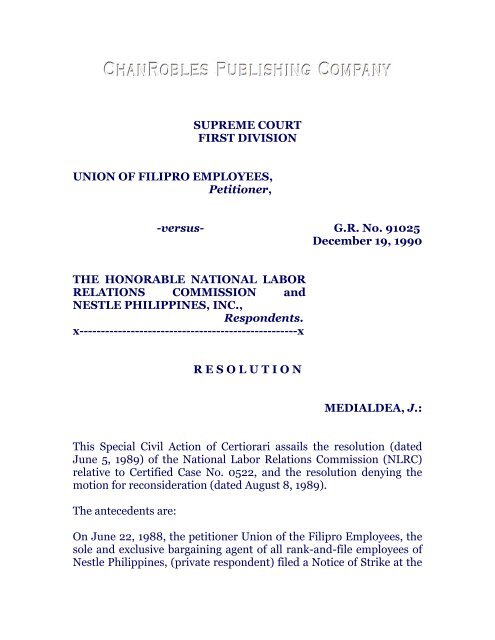
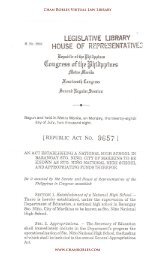
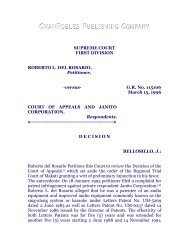
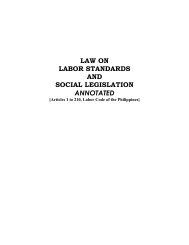
![Aurelio vs. NLRC, (221 SCRA 432 [1993]) - Chan Robles and ...](https://img.yumpu.com/51280528/1/190x245/aurelio-vs-nlrc-221-scra-432-1993-chan-robles-and-.jpg?quality=85)
